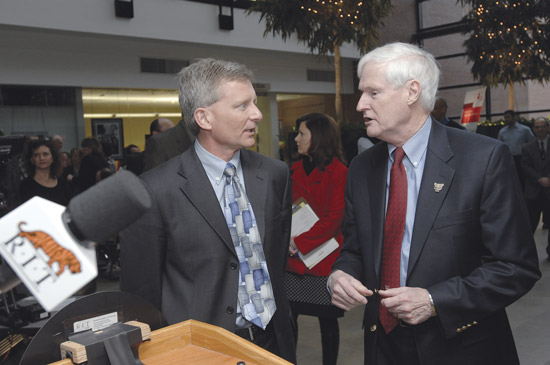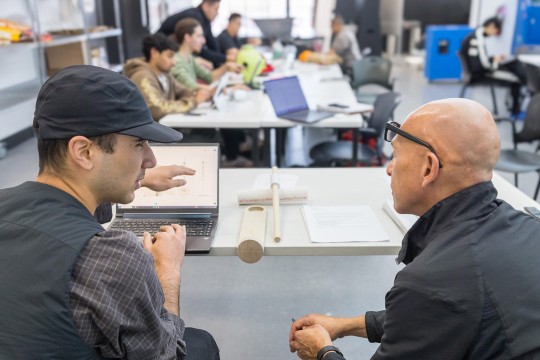Supporting students is new provost's passion
During a visit to campus in the spring, Jeremy Haefner, left, chats with President Bill Destler.
Jeremy Haefner, a veteran administrator and educator from the University of Colorado at Colorado Springs, is RIT's new senior vice president for academic affairs and provost.
Just prior to his arrival at RIT in July, Haefner shared some thoughts about the new job.
What are your priorities as RIT’s new provost and senior vice president for academic affairs?
One of my first tasks will be to immerse myself into the RIT community, culture, and traditions through active listening and participation. I am eager to get started and build practices of regularly meeting and communicating with all our constituents.
Working with the president and the RIT faculty, students, staff, and administration, a second objective will be to assess and rank the priorities for the provost. This will provide me with a solid foundation for moving forward.
A third objective is to ensure that RIT’s strategic plan and the goals and vision of President Destler are part of our core operations. RIT’s success in the future – moving to the next level of greatness and excellence – will be the result of careful and enthusiastic execution of the strategic plan and goals.
Finally, I am passionate about supporting the campus’s student-centeredness and encouraging the campus to become a national leader in this area. I look forward to building collaborations between and among our students and our faculty.
How would you say the University of Colorado at Colorado Springs differs or is similar to RIT?
Like RIT, UCCS has a focus on innovation, but I am particularly impressed with President Destler’s vision around the fusion of creativity and innovation for RIT. This vision appeals to my “creative” mathematics side and to the “innovation” engineering side.
Another similarity is that both campuses are deeply engaged with the surrounding communities. Cooperative learning experiences, industry research projects, K-12 outreach, and service learning activities are just some of the many examples of community engagement that are so important for higher education institutions. RIT has a great history and foundation for community engagement.
Finally, many of the programs and components that make RIT a “Category of One” institution are also those that differentiate it from other universities. The excellence RIT has achieved in cooperative learning, the National Technical Institute for the Deaf, and, of course, the unique academic programs are just some of many examples that make RIT a very special place.
What do you see happening at RIT in terms of academic programs as it moves to become known as an “innovation” university?
It would be great to see “innovation” embedded in the culture of RIT: from the academic programs to the student development activities; from the policies and practices of the provost’s operation to pedagogical techniques used by the faculty; from how RIT engages with the community to how we recruit the “new” student.
I really like the notion of celebrating innovation – Imagine RIT: the Innovation + Creativity Festival is a great example. Highlighting the creative and innovative projects and products created by students and faculty is one of the best ways to build the nation’s premier innovation university.
Without question, RIT is a very special institution. President Destler often speaks to our unfair advantage and I couldn’t agree more. Our job will be to creatively and innovatively seize opportunities to make a positive impact.













